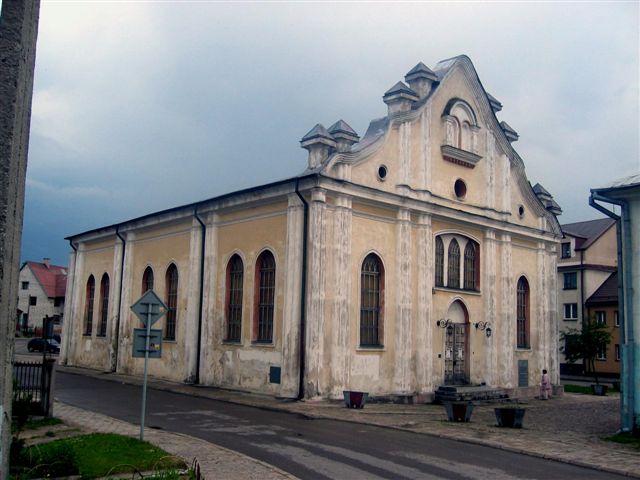 also see Marynowo
also see Marynowo
Alternate names: Sejny [Pol], Seinai [Lith], Synee [Yid], Seiny, Сейны [Rus], Seini, Senya. 54°06' N, 23°21' E. in NE Poland, 17 miles E of Suwałki (Suvalk), near the border with Lithuania. 1900 Jewish population: 1,918. ShtetLink. Sejny is a town in NE Poland in Podlaskie Voivodeship, close to the border with Lithuania and Belarusin the eastern part of the Suwałki Lake Area (Pojezierze suwalskie) on the Marycha river, a tributary of Czarna Hańcza. 1999 population was almost 6,500, with many more inhabiting the area in the tourist season.This town was the capital of a separate powiat. [June 2009]
The Jewish population of Sejny grew rapidly from 72 in 1789 to 222 in 1796. In the mid-19th century, Jews were 72% of all residents. The first years of the 20th century saw a sharp Jewish population decrease as many Jews immigrated to America and other countries. Just before World War II, 25% of the Sejny population was Jewish. In order to stop economic competition from nearby Krasnpola, in 1787 the monks invited Jews to settle in the city. To encourage them, the monks built the first synagogue for them. The city still has a number of buildings belonging to the pre-war Jews of Sejny. The large "White Synagogue" on Pilsudskiego Street, built in the 1860s to replace the wooden predecessor had a Baroque Gothic interior with pillars. replacing an older building. The eastern wall recess held the aron ha-kodesh. The Nazis, who gutted the building and turned it into a fire station, destroyed the polychrome and bimeh. After surrender, the synagogue was used as a warehouse, Restored with a plain, modern interior in 1987, the building now serves as a cultural center, theater, and museum for the Borderland Foundation (Fundacja Pogranicze) dedicated to the cultures of the region, Polish, Lithuanian, Belarusian, Jewish, Ukrainian and Russian. A klezmer band is based at the cultural center. The 19th century yeshiva building also survives. The blue and white building located next to the synagogue once was a yeshiva founded by Rabbi Moses Icchak Awigdor attracting supports of the Haskalah, the Jewish Enlightenment and students from remote areas of Russia and Polish. Briefly the center of Haskalah for all of Lithuania, a conference of the greatest rabbis of Lithuania took place here. The czarist government, fearing the spread of science, banished Awigdor into Russia and closed the yeshiva in Sejny. In the late19th and early 20th century, a cheder functioned with the upper floor used as prayer room. Under the PRL, the building was a slipper factory. Another house, with a Jewish relief at the entrance, is the headquarters of the Borderland Foundation honoring the legacy of Sejny's multicultural communities. In the exhibition hall is a small exhibit of Judaica with a nearby museum of articles from Sejna Jews such as a yad, kiddush cups, candlesticks, and other worship objects. A Hebrew gymnasium was founded here, one of the first Jewish schools of secular nature, where religion was taught in addition to including geography, mathematics and humanities. [June 2009]
CEMETERIES:
- NEW CEMETERY: Established in 1830 just outside the town on the road to Sejnach Augustowa in the village of Marynowo, the Nazis destroyed the cemetery with the devastation continuing after the war. Only single bases of gravestones remain. Gravestones found in foundations in the city were placed in the synagogue building. In May 2002, the "Borderland" unveiled a monument dedicated to the Jews of Sejny at the cemetery. The stone, a pillar on the stylized gravestone is inscribed in English and Hebrew. Theunveiling was attended by numerous guests including Shevach Weiss, Israeli Ambassador in Poland and a great advocate of Polish-Jewish dialogue; Max Cantor, born in Sejny; Mrs. Meir from Israel, whose grandfather was buried in this cemetery; representatives of the Jewish Community of Kaunas, the city and district, and Kazimierz Gacki, pastor of the local Roman Catholic parish. Many local residents attended the ceremony. Photos. [June 2009]
-
There are no signs to the cemetery. It can't be seen from the road due to trees. It is located on the right hand side of a small track on the rightside of the road as you leave Sejny, at the brow of a hill, close to some houses. The only thing visible before you are actually within the overgrown area of the few graves remaining is the recent black memorial pillar. The track leading to it is difficult to identify, but is one of a number of tracks that are within 100 metres or so after a dairy factory and shop on the left of the road. This email address is being protected from spambots. You need JavaScript enabled to view it. [Sept 2016]
- OLD CEMETERY: Founded in the 18th century, the Nazis erased all traces of it during WWII. [June 2009]
Photo courtesy Merle Kastner [June 2015]

